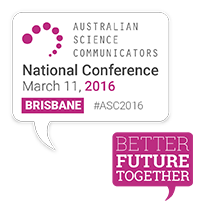Eugenie Lee, one of our speakers for the ASC 2016 conference, is an emerging interdisciplinary artist using her art to communicate the bio-psycho-social experiences of pain-related illness through visual metaphor. Have a read of our interview with her to discover what she thinks of alternative platforms used in communicating science.
ASC: As an artist, how did you find yourself to be a science communicator?
Eugenie: For many years I have been searching for ways to manage my chronic pain disease. During my research I became acutely aware of a huge gap between the way what objective medical science can observe and measure, and what the patient actually feels and experiences. So I began to create something that could bridge the gap between these viewpoints that can generate alternative understandings and meanings. My art residencies for the last three years have allowed me to study and participate in research with the pain scientists at Body In Mind in UniSA and Neuroscience Research Australia. Medical science fascinates me. The evidence based and objective perspectives in science provide the balance to the subjective experience of patients’ experience I’m so familiar with. Translating what I have learned from the pain scientists into a language that can be understood by the general public is an integral part of my art making.
ASC: Why is communicating science important to you?
Eugenie: The Cartesian dualism has been around too long in our culture, including in medical science – with the old idea that our body is like a machine which is separate from our mind, and that pain can be and should be traced back to physical injuries or tissue damage. To my delight, neuroscience was the key to what I’ve been searching for – with the view that it isn’t just about looking for physical tissue damage to explain one’s pain experience; the whole person, and the life surrounding that person also needed attention, in order to manage their pain. What I have learned during my residencies has enlightened me with the latest perspective in pain. Yet their research findings have been somewhat struggling to reach the mainstream culture – part of it is because the Cartesian dualism has been so deeply entrenched in our western culture. Current pain science has moved on well past this centuries old theory, and they have structured their research with the fact that all pain is subjective.
I feel that it is my responsibility as an artist to share the latest knowledge of their research in a way that can be understood by everyone.
ASC: How do you think your artwork conveys science compared to that other forms of communication?
Eugenie: I’ve always been interested in alternative forms of communication as an artist, other than verbal language. This suits my concept of pain in my work because
pain cannot be communicated through a straight forward manner of language – it instead needs mediated, public expression and referential meaning like a metaphor. And art is all about metaphor through visual narratives. I believe communicating through metaphor opens up the possibility of alternative understandings and meaning for the complexities of pain.
Science stands on the objective ground. Pain science acknowledges that all pain is subjective yet as scientists, they observe, measure and record from an objective perspective. Art is subjective. As an artist and a pain patient, I bring in the subjective narrative from my own experience. To convey such complex knowledge of pain, I believe it is imperative to combine both subjective and objective viewpoints. I filter technical lingos attached to the field of medical science so that artworks can communicate through universal language – i.e. visual narratives – that transcend status, age or cultural barriers.
ASC: How would you describe science communication in 140 characters or less?
Eugenie: Art&science communication explore what’s relevant to us. Together they can have greater effect that can transcend language/cultural barriers.
Eugenie would like to thank her sponsors:
Check out more information about the ASC 2016 conference and register here.


